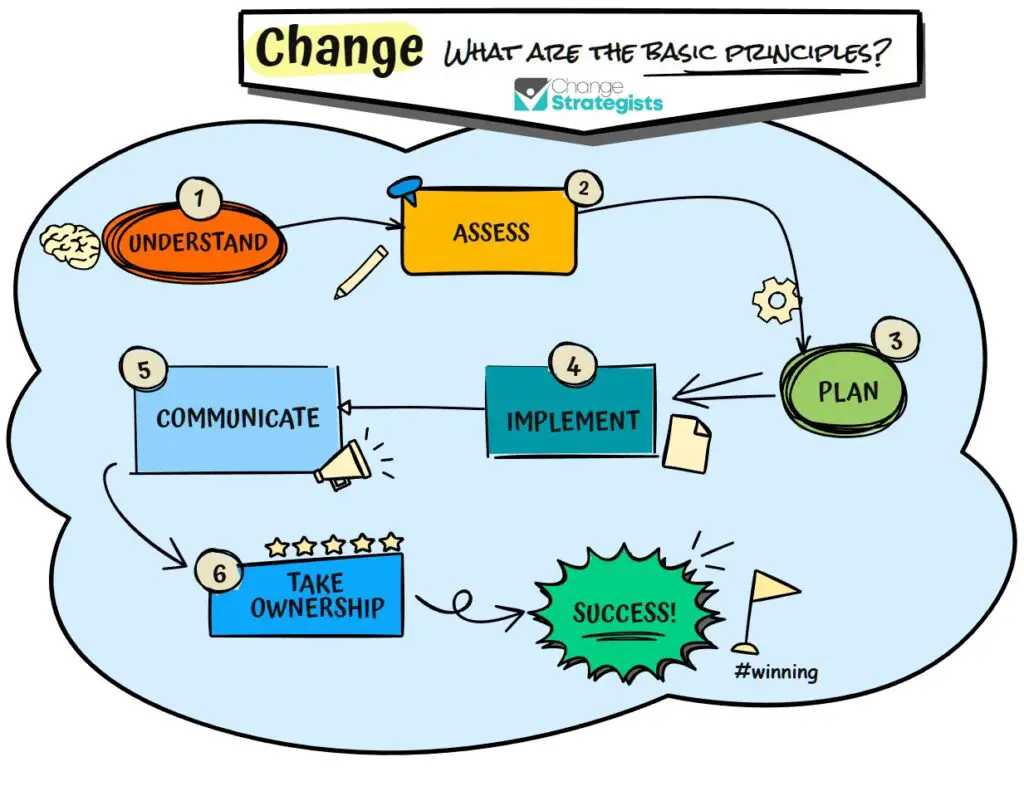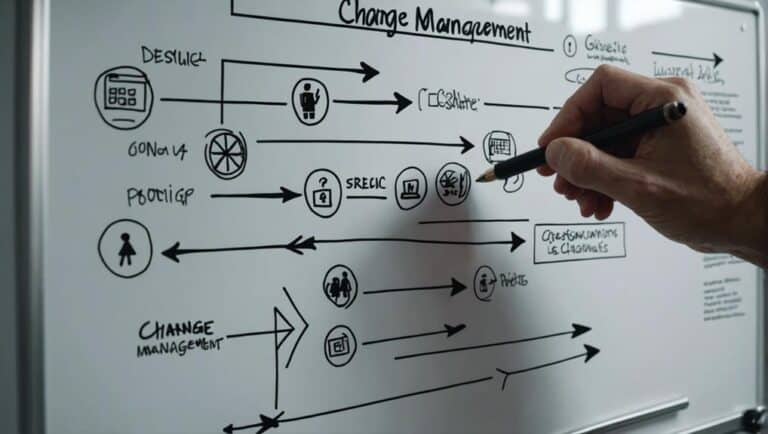Organizational changes are a norm for businesses and organizations nowadays. However, many organizations slowly die out when they refuse to improve on these changes. What makes change management successful and how it can be improved to stay competitive?
Change management can be improved by communicating effectively, monitoring the impact of change, understanding change levels, automating approvals, and documenting data. Continuous improvement to the change management process and changes are vital for an organization’s survival in a competitive environment.
Change management is the process of bringing about change within an organization. It includes both the proactive and reactive methods used to manage changes in all aspects of a business, from its products and services to its people, processes, and systems.
It is important for businesses because it helps them stay agile and adaptable in a constantly changing marketplace.
By managing changes effectively, businesses can avoid disruptions that can lead to lost revenue or market share.
When done properly, change management can also help businesses improve their bottom line by increasing efficiency and reducing costs.
It’s therefore important that organisations look into how they can improve their internal change management processes to maximise the benefits on offer.
Having no formal processes in place doesn’t mean change isn’t happening, it means you’re not in control of it. Improve the situation by ensuring that everyone involved is aware of what is required of them.
Businesses are operating in an ever-changing environment. Managers often implement changes without improving them, leading to more significant problems. There are a variety of improvement steps and techniques that your organization can use depending on your needs and circumstances. We’ll explore these in detail in this article.
Six Ways for Improving Your Change Management Process
If you’re just getting started, or you have a change management process in place, there are always improvements that can be made. You must ensure you are continuously improving on that process based on feedback from all the stakeholders and the results achieved.
Here are six ways that can help you improve your change management process to ensure better results:
Learn to Classify Changes
The most crucial step on your journey to improving your change management process is to understand the different kinds of changes an organization goes through, prioritize and then execute them accordingly.
Emergency changes
As the name suggests, these will be urgent and come without notice. Their root cause is usually a security breach or a new technology malfunctioning. These need to be executed without delay to avoid any considerable losses to the business. Change makers and stakeholders need to give the go-ahead on these immediately.
Normal Changes
These are routinely scheduled and take their sweet time and protocol to implement. These are usually the result of a change request and are thoroughly reviewed by all stakeholders and change managers before approval. These changes touch multiple aspects of your organization and will be less frequent than the others.
Standard Changes
The most frequent and routine changes in your organization are called standard changes. These are so common that they don’t need the involvement of all stakeholders. These are the kind of changes that can be easily automated to introduce efficiency in a worker’s schedule.
Introduce Effective Documentation
How would you or anyone new in the organization track changes back to their origin and see what the process was? The answer is meticulous documentation. Documentation allows us to see the data and visualize it however we want.
Without proper documentation, the same mistakes can happen twice or even more. It’s best to document change requests, success rates, KPIs, average task completion times, and organizational impacts of the change for future review.
This is especially important if you are required to report back to the senior management team if something goes wrong. The documentation will provide a structured approach to tell the story of events and key steps leading up to the problem.
Utilize Change Templates
There are various basic templates available that can be applied and modified to fit the changes. Standard changes benefit from templates the most since these are predictable changes and are done frequently.
Emergency changes can also use templates, but change managers can be allowed to make changes to these templates to ensure these changes are implemented faster.
Having templates in place allows proper management of change within an organization. It will enable organizations to anticipate changes and ensures proper documentation.
Utilizing Automation
Organizations benefit from automating approval processes. This removes manual labor from trying to get approvals on time and speeds up the change-making process.
Standard and regular changes are pre-approved, so automating processes can work well for these changes. Change templates can have automated processes to back them, allowing smoother execution.
Ensure Visibility at all Stages
The key to evaluating change is visibility across all stages, including pre-change, during the transition, and post-change periods. It is essential to observe each step keenly and assess them later to see what improvements can be made.
Visibility also means change-makers must be prominent and vocal for their employees going through these changes. Being accessible ensures employees feel at ease and can reach out to you whenever needed.
Clear Communication
The most crucial part of improvement is communicating them to those involved in the process. Once you’ve evaluated the process and understand where modifications are required, you need to share the need and areas of improvement with stakeholders and employees.
Clear communication during this phase will enable you to establish a culture of easy adaptation to change and will give the message that continuous improvement is vital for the organization’s survival.

The Impact of Change Management at Different Levels
Although change management should occur across the entire organization, there are differences between these levels.
If you are looking to deploy a continuous improvement process for it, you need to understand how change is translated and managed at different levels:
Individual Level
At the individual level, change management deals with the employees that have to implement the change. They must understand how they contribute to change and their roles in the process. A good change manager will involve employees at the individual level by:
- Setting clear goals for employees
- Communicating roles and responsibilities clearly
- Motivating employees to try new things and techniques
- Be available for guidance and support throughout the process
It is natural for employees to resist change as it asks them to go the extra mile and work outside their usual roles. Change is also a time of uncertainty, and employees may feel their jobs are at risk. It is important to handle things effectively at this stage to ensure a smooth transition.
Organizational Level
Once the employees and other stakeholders are up to speed, the organizational change begins. This involves implementing the change across different teams and departments in the organization.
Substantial documentation and strict usage of templates must be ensured at this stage to ensure success and data collection for later improvements.
There should be proper planning for implementation at every level in the organization, including who is responsible for which roles during the transition period.
Enterprise Level
Once the change has been implemented, it becomes a regular part of the way you do business. This level deals with improving the company and making it flexible for changes.
The change has now become a part of the standard company processes and documentation and will be improved upon when necessary.
What are the Different Levels of Change Management
Understanding how organizational culture is impacted will help you shape your approach. In essence, there are three levels of change management:
1) The Pre-Planning Level: This is the level where you and your team identify what needs to change, why it needs to change, and how you will go about achieving the desired outcome. This includes identifying who will be responsible for each phase of the process, developing a timeline and milestones, and creating a communication plan.
2) The Implementation Level: At this stage, you and your team are actually implementing the changes. You need to ensure that everything is running smoothly, communicate with all stakeholders regularly, and make any necessary adjustments as needed.
3) The Maintenance Level: Once the changes have been implemented and are working as planned, it’s time to move onto the next set of changes.
Basic Principles of Change Management
With all the above in mind let’s consider what basic principles you should follow to ensure change is handled effectively first time.

Understand
Before your organization can put a change management process in place, they have to commit to the idea of change. Every stakeholder must understand the importance of chance and why they must go through it.
Employees generally feel anxious and fearful in the face of change, and it’s crucial that the leadership can explain the negative consequences if it is not implemented.
Employees tend to respond to changes better and adopt them faster when they feel supported and motivated by the leadership. Here are a few must-haves for ensuring acceptance and understanding at all levels
- Communicate the objectives of change clearly
- Relay the benefits of the shift in the company and the employees
- Clarify the employees; role in the process
- Clarify the impact of the change on the staff and the workflow
Doing the above steps ensures clarity and removes any uncertainty from the employees’ minds.
Assess
People are an amalgamation of their beliefs and their experiences. It is important that before you start planning to implement a change, you assess whether it fits the cultural landscape of your organization or not.
Take a closer look at your employees, their beliefs, their environment, and preferences, and then analyze whether the change you are proposing fits them or not.
Having a more profound knowledge of how your employees think, and their cultural inclinations will also help show that you care about making changes that benefit them and the organization.
Plan
A written plan goes a long way to ensure you don’t lose sight of what needs to be achieved through the change.
They ensure change-makers and stakeholders remain on top of the real objectives of the process and the milestones that need to be achieved.
You should be realistic about the timelines and the resources required to make the change. Here is what you need to develop a plan for your change management process
- Sponsorship and strong buy-in from the executives and stakeholders
- Identification of resources internally and externally to help plan and implement the change
- An assessment of the impact the change will have on customers, vendors, and employees
And these are the crucial elements every plan should include:
- An analysis of the current state of things and expected results after the change has been implemented
- Clear reasoning behind why change is needed and its benefits
- Clear evidence that achievement of the set KPIs is possible for the organization
- Precise details of all the steps and decisions that need to be taken at each level in the organization
Implement
It’s time to implement the plan of change you developed. One good way to achieve this is to designate certain employees as change agents within the company.
You need to train these employees so they can answer questions and guide other employees in your place.
A good change manager is a role model to motivate other employees.
Communicate
One of the biggest mistakes made is spending hours and hours creating plans and strategies while ignoring the importance of effective communication. Communication is the backbone of change.
Regular updates to stakeholders and communication with the employees ensure milestones are executed on time.
You can arrange two-way meetings to let stakeholders listen to employee feedback first-hand. Keep calm and appear steadfast when talking to employees to avoid any strong reactions.
It is best to address fears and anxiety hands-on and appreciate employees for small wins. Motivating them goes a long way in ensuring they stay on the path of change.
Take Ownership
Taking ownership at every level during the change-making process is crucial to its success. When people are personally attached to and invested in a process, they take the responsibility to ensure its success.
Again, this is an area where having change leaders within each department can help your initiative. It also helps to take a coaching approach rather than an authoritative one. Allow the employees to go through the process and make suggestions rather than imposing your way of doing things on them.
Starting an incentive mechanism where leaders and employees are rewarded for taking ownership and delivering on milestones.
Advantages of Continuous Improvements in Change Management Process
Rigidity doesn’t help anyone. A culture of improvement helps a business thrive and adapt to new ways of doing things.
Organizations that invest in improvement plans and strategies ensure they survive tough times and improve their products, customer experience, and revenue generation.
Apart from saving costs and improving efficiency, here are some other benefits that come with encouraging a culture of improvement in your organization:
Better adaptability to change
If your organization and employees are used to doing things as is, anything new will always be perceived negatively. However, if continuous improvement is a part of your culture, employees and stakeholders will get used to changes and accept new ideas.
Boosted morale
Continuous improvement allows your employees to test out their skills in different settings. It encourages a dynamic environment where they can exercise creativity and think outside the box.
Boosted motivation
A working culture that allows employees to improve on the way they do things instead of following your old processes all the time helps them stay motivated. It will enable them room for growth as professionals, which is an exciting career opportunity for them.
Frequently Asked Questions
What is change management?
Change management is the process or steps involved in helping an organization transition. It allows organizations to measure changes and their effectiveness in day-to-day business activities and helps them navigate bigger transitions.
What are the types of change management?
There are three main types of change management – developmental, transitional, and transformational. The kind of change applicable in an organization depends on the organization’s needs and situation.
Final Thoughts
Change management is a continuous process within an organization. Effective change management requires continuous improvement in the process and the changes implemented. Organizations that invest in improvement plans are more dynamic, with employees that welcome new ideas and changes. We hope the strategies listed in this article will help you improve your change management strategies.





